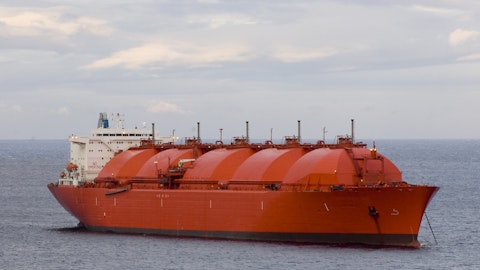Operator: Thank you. We’ll now move on to our next question. Please standby. Our next question comes from the line of Chris Tsung from Webber Research. Please go ahead. Your line is open.
Chris Tsung: Hey, good afternoon, Karl and Eduardo how are you?
Karl Fredrik Staubo: Oh, good. Yes.
Chris Tsung: Thank you. Just looking at your presentation, it looks like the cost for Mark II increased around 77% like, I think you guys said 300 million last quarter. So just wanted to ask is that higher price from like a higher cost environment or is it just ordering more equipment and just lumping in, a second part of this is, does that change your guidance on what the dollar per ton costs for FLNG?
Karl Fredrik Staubo: I assume you’re referring to slide 15. And the balance of what we use for illustrative purposes, which slide 15 is meant to be, is that we use the dollar per tonne that you derive out on slide 14. So we just set up you buy Golar today at 590. You use 590 at the same basis. What would that equate to? An implied liquefaction earnings or cost versus EBITDA. We do believe that we can create the Mark II somewhat cheaper than that.
Chris Tsung: Okay, yes, cause I think in the prior earnings. You guys got it to around like 500 to 600 at a tonne.
Karl Fredrik Staubo: Maintained that planning.
Chris Tsung: Okay, you maintained that?
Karl Fredrik Staubo: Yes.
Chris Tsung: Okay, great. Thanks. And my second question, I think you’ve touched on this before as well, just how much liquidity could you unlock if you refinance Gimi and Hilli?
Karl Fredrik Staubo: Eduardo, you want to tackle that one?
Eduardo Maranhão: Yes, sure. So I think we discussed that on the previous call. We have assessed a different number of alternatives to potentially extract further value from Hilli and Gimi. Depending on which one we would pursue, we could see the potential to unlock just on Gimi alone values of in excess of $1.2 billion to $1.3 billion. That would require a further refinancing of the existing facility. And we could be doing that either in the capital markets or pursuing a new commercial bank facility. We still believe that we would be better off eliminating completely the construction risk. So we don’t expect to take any sort of refinancing activities before the commencement of operations of Gimi. I think, with the current cash position that we have, and as discussed and pointed out by Karl as well, further enhanced by the cash flow generation from Hilli, we have more than enough to sustain both further growth on FLNG, but also to commence payments in the near future.
So I think we will try to be optimistic when it comes to refinancing.
Chris Tsung: Great, that’s it for me. Thank you guys. Thank you.
Eduardo Maranhão: Thank you.
Operator: Thank you. Our next question comes from the line of Liam Burke from B. Riley Financial. Please go ahead. Your line is open.
Liam Burke: Thank you. Hi, Karl, how are you?
Karl Fredrik Staubo: Good.
Liam Burke: Karl, are you seeing any competing FLNG players in the market looking for potential projects that you would think would be more in line with Golar?
Karl Fredrik Staubo: I think the biggest competitor as such as major stuff control fields, building the assets for own balance sheets, or like what VPN Kosmos is planning on the expansion of Tortue.
Liam Burke: Okay, but you don’t see any players like NFE stepping in and competing for that for your business.
Karl Fredrik Staubo: As we’ve said on numerous occasions when it comes to NFE we think that the first LNG technology that they are pursuing is complementary to that Golar. They are mainly targeting smaller resources in shallower waters and seem to focus mainly on U.S. Gulf of Mexico. And we think that’s complementary to those projects that we are pursuing and we like their technology and think that they have, again, complementary technology to ours and don’t see them as a direct competitors for any of the projects we are currently developing.
Liam Burke: Okay, great. Thanks Karl.
Karl Fredrik Staubo: Thank you.
Operator: Thank you. We’ll now move on to our next question. Our next question comes from the line of Ben Nolan from Stifel. Please go ahead. Your line is open.
Ben Nolan: Hi, I told you I’d be back. I wanted to just cover a little bit more on the Mark II. In the presentation, you said that you’re confirmed, you have a shipyard slot confirmed for 2025 delivery. I’m curious when you would need to have the vessel in the yard in the first place or when you would actually start spinning other than for the acquisition of the ship and log me tonight is the actual construction of that. And could you remind us what you’re thinking in terms of what the total CapEx cost for Mark II would be?
Karl Fredrik Staubo: Sure. So, okay, Mark II is slightly different in sort of concepts than that of Mark I. So if you go for example, on slide 13, you can see that the liquefaction plant itself is planned to be built from scratch on a new ships midsection. Then you bring the ship in, you basically chopped the ship in the middle and you weld on the ship to either side of the liquefaction plant. Hence, to keep that schedule, we will start to construct the mid-section where the vast majority of the is intended for. And then we would need the ship to be in the shipyards to start preparation work on the ship itself this time next year. So for us, it’s more important to get going on the midsection than to get shipped into the shipyard, this side or during this year.
So that’s how this unit is built, which means that it’s less stick building into an existing unit. You basically put the liquefaction plant in the middle and then add the storage. In terms of CapEx, it’s slightly dependent on what mooring system that we will end up using, because we believe around somewhere between 1.8 and on 2 billions should be feasible.





